
The Hope Bay incident occurred in February 1952 at Hope Bay on the Antarctic Peninsula. It involved an Argentine naval party from their onshore base and a British landing party from their survey ship.

The Hope Bay incident occurred in February 1952 at Hope Bay on the Antarctic Peninsula. It involved an Argentine naval party from their onshore base and a British landing party from their survey ship.
During the 19th century there had been increasing interest by various countries in the uninhabited, largely unexplored, and unclaimed continent of Antarctica and its many off-shore islands. The United Kingdom was first to lay formal claim which it did in Letters patent of 1908. This defined the boundaries of areas it claimed as dependencies of its Falkland Islands colony. One dependency was Graham Land on the Antarctic Peninsula, at the northern tip of which is Hope Bay. [1] Chile, in 1940, was next to define its claimed areas of Antarctica, and Argentina established its claim in several stages between 1940 and 1947. The claims of all three countries, including to the Antarctic Peninsula, overlapped. [2] The United States was also showing an interest in laying its own claim to the same area. [3]
In 1943, Britain began establishing bases in the region to protect Allied shipping using the Drake Passage from attacks by German raiders during the Second World War. This coincided with attempts by Argentina, a country sympathetic to Germany, and to a lesser extent by Chile, to establish bases of their own to strengthen their claims to this section of Antarctica. This led to a series of incidents on the Antarctic Peninsula and the out-lying islands which continued after the end of the war. [4]


In 1948, a British research base at Hope Bay was destroyed by fire and subsequently abandoned. It was operated by the Falkland Islands Dependencies Survey (FIDS). Soon afterwards, a manned Argentine base was established a few hundred metres away from the abandoned British base. In February 1952, the FIDS survey ship, John Biscoe, arrived with equipment and stores to rebuild the fire-damaged base. The Argentines warned off the landing party, fired a machine gun over their heads and the landing party then withdrew back to the John Biscoe which returned to the Falklands. The Governor of the Falkland Islands and its dependencies, Sir Miles Clifford, sent a telegram to the Colonial Office in London, saying: "this presumably constitutes an act of war". [5] Without waiting for a reply, and ignoring existing Foreign Office instructions to the contrary, he boarded the frigate HMS Burghead Bay and, with an accompanying detachment of marines, escorted the John Biscoe back to Hope Bay, where they arrived on 4 February. [6] The show of strength forced the Argentines to retreat and provided protection while the British base was rebuilt. [7] [8] On 7 February, while still on duty at Hope Bay, Burghead Bay ran aground in severe weather. This mishap prompted a court martial in November 1952. The frigate eventually limped to Stanley with the governor and its passengers on 10 February. [8]
The Argentine authorities had already issued an apology in the aftermath of the 1 February eviction of British personnel and said the commander at the base had exceeded his authority. [9] However, the real reason behind the incident was its likely propaganda value, as part of the Argentinian leader, Juan Peron's, nationalist Antarctic Dream. [10] When the Argentine base was relieved, Peron greeted the members of Esperanza Detachment with a hero's welcome. [11]

The British Antarctic Territory (BAT) is a sector of Antarctica claimed by the United Kingdom as one of its 14 British Overseas Territories, of which it is by far the largest by area. It comprises the region south of 60°S latitude and between longitudes 20°W and 80°W, forming a wedge shape that extends to the South Pole, overlapped by the Antarctic claims of Argentina and Chile. The claim to the region has been suspended since the Antarctic Treaty came into force in 1961.

Operation Tabarin was the code name for a secret British expedition to the Antarctic during World War Two, operational 1943–46. Conducted by the Admiralty on behalf of the Colonial Office, its primary objective was to strengthen British claims to sovereignty of the British territory of the Falkland Islands Dependencies (FID), to which Argentina and Chile had made counter claims since the outbreak of war. This was done by establishing permanently occupied bases, carrying out administrative activities such as postal services and undertaking scientific research. The meteorological observations made aided Allied shipping in the South Atlantic Ocean.

Hope Bay on Trinity Peninsula, is five kilometres long and three kilometres wide, indenting the tip of the Antarctic Peninsula and opening on Antarctic Sound. It is the site of the Argentinian Antarctic settlement Esperanza Base, established in 1952.

Esperanza Base is a permanent, all-year-round Argentine research station in Hope Bay, Trinity Peninsula. It is one of only two civilian settlements in Antarctica. The base's motto is Permanencia, un acto de sacrificio.

James Ross Island is a large island off the southeast side and near the northeastern extremity of the Antarctic Peninsula, from which it is separated by Prince Gustav Channel. Rising to 1,630 metres (5,350 ft), it is irregularly shaped and extends 64 km in a north–south direction. It was charted in October 1903 by the Swedish Antarctic Expedition under Otto Nordenskiöld, who named it for Sir James Clark Ross, the leader of a British expedition to this area in 1842 that discovered and roughly charted a number of points along the eastern side of the island. The style, "James" Ross Island is used to avoid confusion with the more widely known Ross Island in McMurdo Sound.
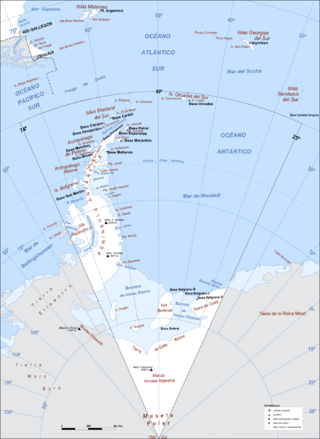
Argentine Antarctica is an area on Antarctica claimed by Argentina as part of its national territory. It consists of the Antarctic Peninsula and a triangular section extending to the South Pole, delimited by the 25° West and 74° West meridians and the 60° South parallel. This region overlaps with British and Chilean claims in Antarctica. None of these claims have widespread international recognition.
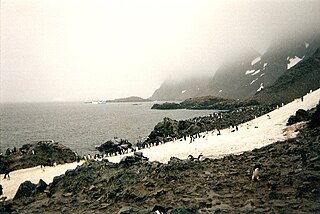
Laurie Island is the second largest of the South Orkney Islands. The island is claimed by both Argentina as part of Argentine Antarctica, and the United Kingdom as part of the British Antarctic Territory. However, under the Antarctic Treaty System all sovereignty claims are frozen, as the island lies south of the parallel 60°. Buchanan Point at the north-eastern end of the island, with Cape Whitson on its south coast, are Important Bird Areas.

Adelaide Island is a large, mainly ice-covered island, 139 kilometres (75 nmi) long and 37 kilometres (20 nmi) wide, lying at the north side of Marguerite Bay off the west coast of the Antarctic Peninsula. The Ginger Islands lie off the southern end. Mount Bodys is the easternmost mountain on Adelaide Island, rising to over 1,220 m. The island lies within the Argentine, British and Chilean Antarctic claims.
Lavoisier Island is an island 29 km (18 mi) long and 8 km (5 mi) wide, lying between Rabot and Watkins Islands in the Biscoe Islands, Antarctica. It is separated from Renaud Island and Rabot Island to the northeast by Pendleton Strait, from Watkins Island to the southwest by Lewis Sound, and from Krogh Island to the west-southwest by Vladigerov Passage.

The French Antarctic Expedition is any of several French expeditions in Antarctica.
The British Antarctic Survey (BAS) is the United Kingdom's national polar research institute. It has a dual purpose, to conduct polar science, enabling better understanding of global issues, and to provide an active presence in the Antarctic on behalf of the UK. It is part of the Natural Environment Research Council (NERC). With over 400 staff, BAS takes an active role in Antarctic affairs, operating five research stations, one ship and five aircraft in both polar regions, as well as addressing key global and regional issues. This involves joint research projects with over 40 UK universities and more than 120 national and international collaborations.
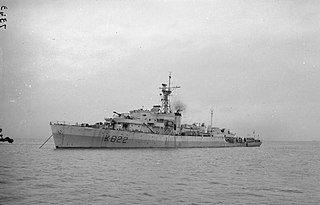
HMS Burghead Bay was a Bay-class anti-aircraft frigate of the British Royal Navy, named for Burghead Bay in Morayshire.

Arrowsmith Peninsula is a cape about 40 miles (64 km) long on the west coast of Graham Land, west of Forel Glacier, Sharp Glacier and Lallemand Fjord, and northwest of Bourgeois Fjord, with Hanusse Bay lying to the northwest. It was surveyed by the Falkland Islands Dependencies Survey (FIDS) in 1955-58 and named for Edwin Porter Arrowsmith, Governor of the Falkland Islands.

HMNZS Endeavour was a Royal New Zealand Navy Antarctic support vessel. She was the first of three ships in the Royal New Zealand Navy to bear that name.
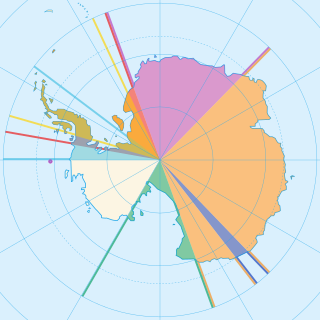
Seven sovereign states – Argentina, Australia, Chile, France, New Zealand, Norway, and the United Kingdom – have made eight territorial claims in Antarctica. These countries have tended to place their Antarctic scientific observation and study facilities within their respective claimed territories; however, a number of such facilities are located outside of the area claimed by their respective countries of operation, and countries without claims such as China, India, Italy, Japan, Pakistan, Russia, South Africa (SANAE), Poland, and the United States have constructed research facilities within the areas claimed by other countries. There are overlaps among the territories claimed by Argentina, Chile, and the United Kingdom.
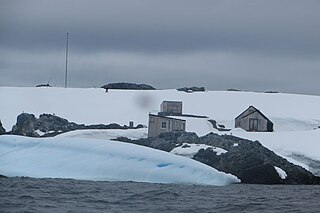
Detaille Island is a small island off the northern end of the Arrowsmith Peninsula in Graham Land, Antarctica. From 1956 to 1959 it was home to "Base W" of the British Antarctic Survey and closed after the end of the International Geophysical Year (IGY). Detaille was a key monitoring sites during the IGY. It is now often visited by Antarctic cruise ships but is otherwise unoccupied.
Nobby Nunatak is a nunatak, 270 m, standing 1 nautical mile (1.9 km) south of Lake Boeckella and 1 nautical mile (1.9 km) east of Mount Flora, at the northeast end of Antarctic Peninsula.
Piggott Peninsula is a broad snow-covered peninsula between New Bedford Inlet and Wright Inlet on Lassiter Coast, Palmer Land, Antarctica. It is bounded to the west by Bryan Glacier and Swann Glacier.
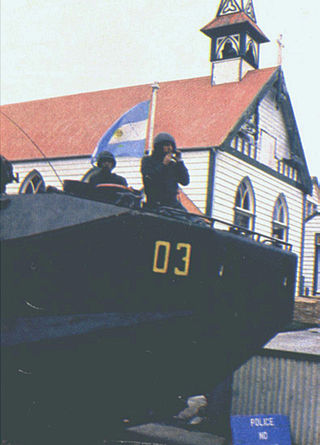
The South Atlantic conflict was a series of crises, undeclared wars, and other conflicts between Argentina, the United Kingdom, and later Chile in the Southern Atlantic Ocean. It was incited by the Argentine navy's prevention of the UK's reoccupation of its territories on the Antarctic Peninsula, and included the Falklands War and Invasion of South Georgia. The conflict, despite a large number of stalemates, ultimately ended in British victory.

The Deception Island incident took place in February 1953 when a group of British Royal Marines landed on Deception Island in Antarctica, took two Argentine sailors prisoner and destroyed an Argentine Navy base. A nearby Chilean base was also destroyed.